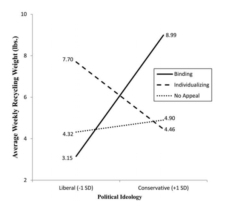Taking Out The Trash
Monday’s post cited a study that didn’t move the needle and sleuthed the problem to a water is wet finding; people are different and therefore, require different messaging to be effective.
Here’s a soothing balm, a winning study that avoided this mistake.
Researchers recruited participants with help from the local government to have their recycling bins outfitted with an RFID tag to precisely measure recycling behavior. They used the first five weeks to establish a baseline of household recycling and then sent randomly assigned households communications in one of three conditions;
- appeals promoting recycling that invoked Binding norms
- appeals invoking Individualizing moral norms
- and a control group
What the hell does Binding and Individualizing mean? These are two ways to morally frame a message. Moral framing 3-5 are Binding, 1 and 2, Individualizing.
- Harm/Care: basic concerns for the suffering of others, includes caring and compassion.
- Fairness/Reciprocity: concerns for inequality or more abstract notions of justice
- Ingroup/loyalty: self-sacrifice for the group, feeling obligate to the group, vigilance against betrayal
- Authority/Respect: social order and appreciation of hierarchical relationships, sense of respect and obedience
- Purity/Sanctity: concerns about wholesomeness and physical and spiritual contagion.
After the three month test period of baseline plus new messaging the households were sent a survey to measure, among other things, their political ideology. Why ideology? Conservatives tend to form moral judgements on Binding aspects of morality and therefore, more likely to adhere to social norms of their in-group (defined in lots of different ways – work, church, friends, family) The group serves as the marker for what is moral and tight knit communities serve to maintain this order.
Liberals are more focused on caring and fairness and using the individual as the reference point for determining good/bad moral behavior as they seek to protect the individual from harm and mistreatment.

The results are nothing short of staggering.
- First off, Conservative households recycle as much as liberal ones with no intervention. This is the dotted line in the graphic below. There is no statistical difference.
- Second, when matched correctly, both groups greatly increase their recycling behavior – e.g. from 4.9 to 8.99 lbs for conservatives.
- And when mismatched, the amount of recycling actually goes down – e.g. 4.32 to 3.15 lbs for liberals.

How do you think your own control is doing? Does it perform equally well for everybody? Why is your test going to a random nth group that assumes the impossible – that everyone who receives it is the same?
People are different and in predictable ways. Yet, they rarely reveal themselves with:
- Superficial (e.g. demographics) or
- Random (the clustering to nowhere so popular now) or
- Behavior based groupings (tells you next to zero about why).
Digging deeper by using theory is what’s required to get beyond one-size-fits-nobody and avoid the infinity problem when pondering the “how to segment and where to start” question.
Applying the science of “why” also greatly increases your chance of success. And success isn’t just segmentation success, it’s mission success. You are likely leaving almost countless dollars on the table by mismatching message to audience.
Kevin


